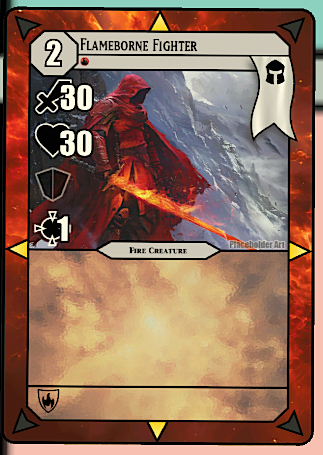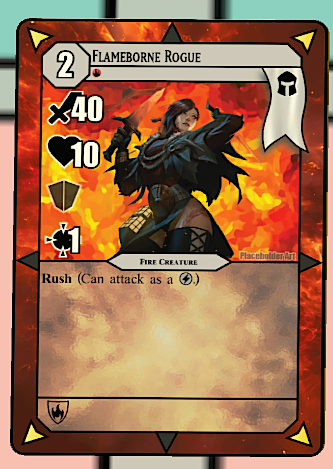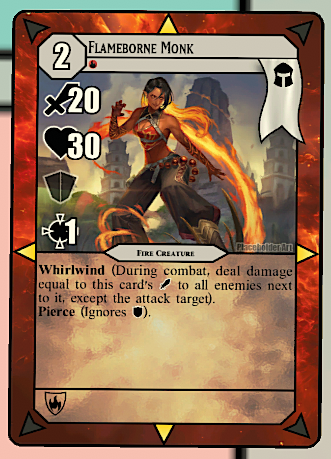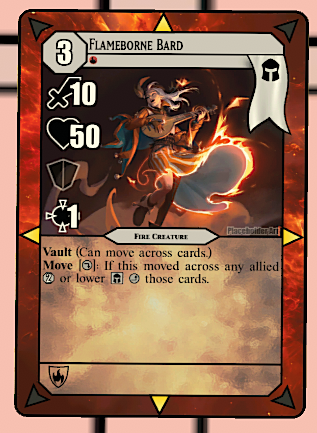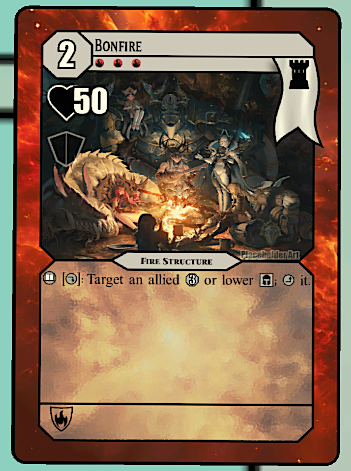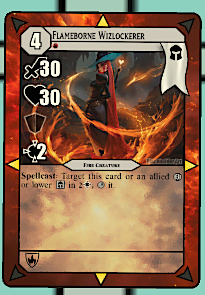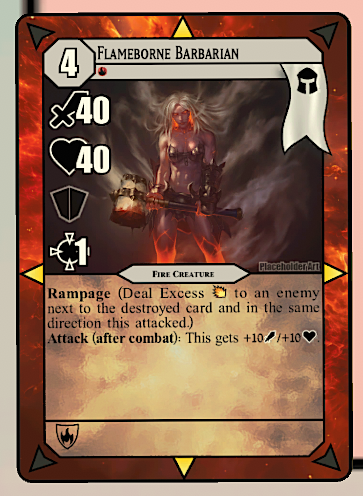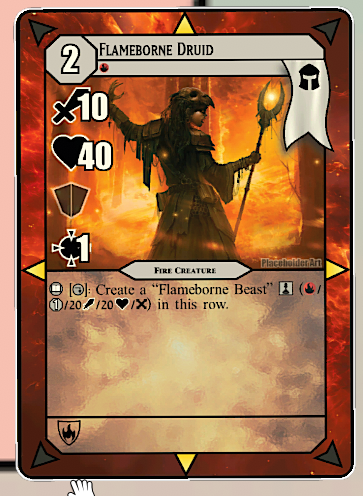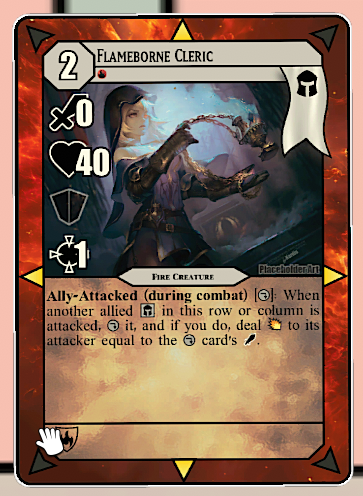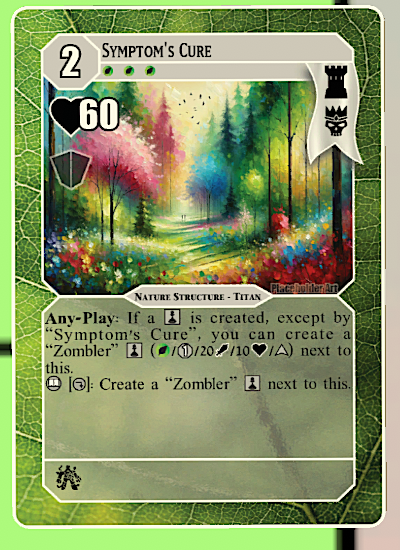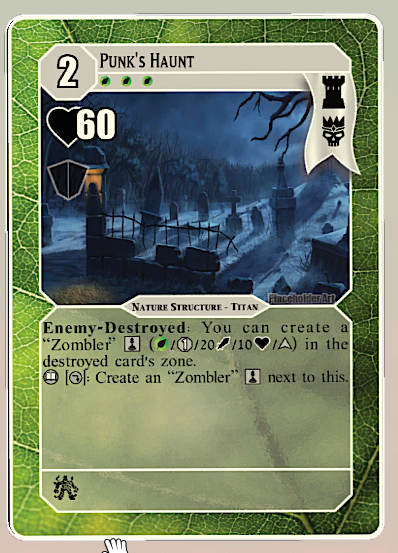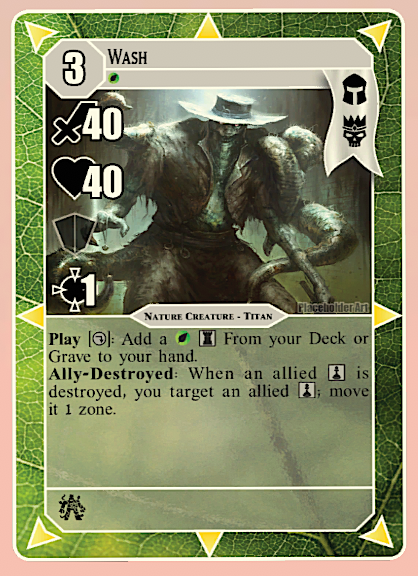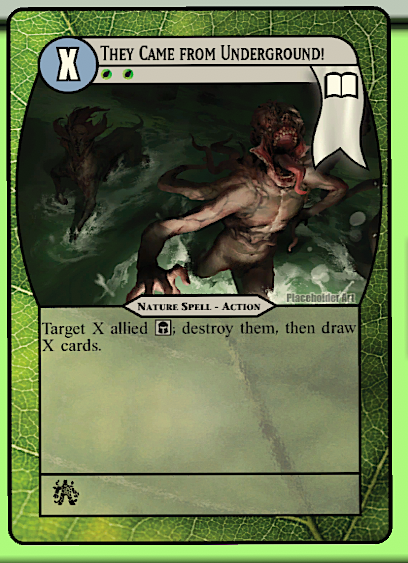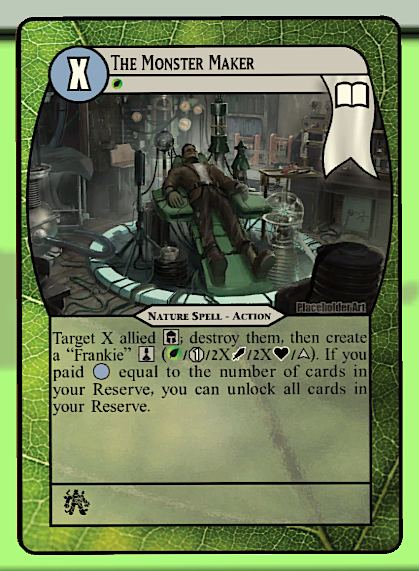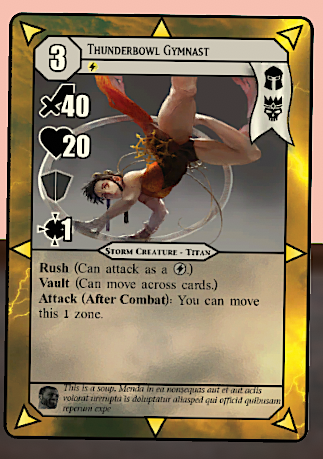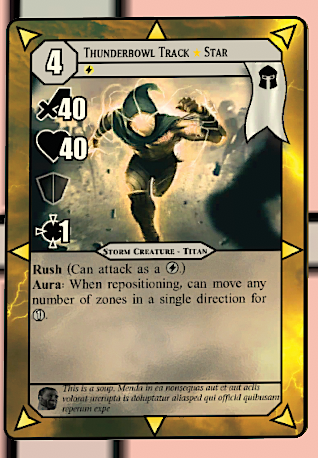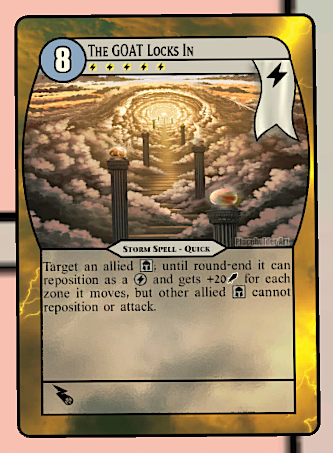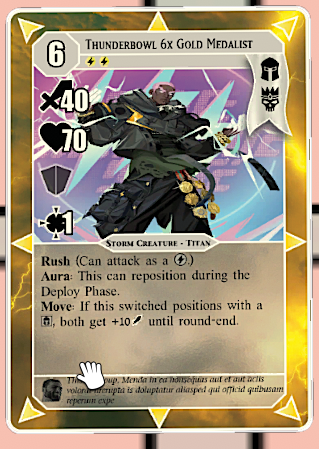Designing 3 Factions for a Competitive Card Game
Starting with Design Goals
Factions should support the three classic play-styles - Aggro, Control, Combo : Factions should support the three classic card game playstyles, Aggro (Early Aggression), Control (Defensive attrition), and Combo (Setup until getting a powerful combination of cards.)
Factions should expresses themes mechanically: If a faction has a certain thematic, it should reflect in the mechanics of the faction.
Factions should fit player expectations of element and respect element design restrictions: Elements in Empyre are seperated by mechanical identity - certain elements use certain mechanics and play patterns. Any factions designed should respect these restrictions
Factions should function as an effective deck on their own: Despite two factions forming a deck, no one faction should have such severe weaknesses in overall gameplay as to make them ineffective on their own.
Factions should have synergy with itself: Cards in a faction should work together to create a greater effect.
Factions should have synergy with other factions, or at least no anti-synergy: Factions should be able to have synergy with each other and not have effects which interfere too heavily with each other.
Faction synergies should be understandable at a glance: No faction should require in-depth knowledge of all of the cards to understand how to execute its synergistic aspects.
Factions should deliver on their Complexity Level: Each set has a Complexity Level which helps new players identify the difficulty of using that faction. Factions should contain complexity that matches its label.
Factions should utilize board positioning: Positioning, positional effects and movement are all key parts of Empyre, so each Faction should utilize them in some way.
Designing a Simple Faction - Flameborne
Basic Concept: Straightforward aggressive faction with creatures that refresh for multiple attacks.
Mechanical Identity: Cards refresh each other for multiple attacks, and are more effective when lined up in rows or columns.
Thematics: A Heroic Dungeons & Dragons party.
How Flameborne expresses elemental themes and mechanics: Fire is an aggressive element focused around attacking. To get value out of refreshing creatures (bringing them out of an exhausted, or ‘used up’ state) players are incentivized to move creatures forward onto the enemy field so they have more targets for attack.
How Flameborne utilizes positioning: Players are encouraged to arrange their creatures in the same row or column.
How Flameborne expresses Synergy:
Cards which Refresh
Cards which benefit from attacking - attacking is the main way to Exhaust cards (making refreshing them later possible.)
Cards which Exhaust to use abilities - abilities which cause cards to Exhaust can also be repeated if cards are refreshed.
Creating Guidelines to Design a Simple Complexity Level Faction
Cards should not have too much text or too many abilities: Effects should be kept to a minimum, with most creatures not having more than 2 effects. Some exceptions can be made for especially high cost or powerful cards.
Cards should not require deck knowledge to use effectively: Players should be able to use their cards without knowing the rest of the cards in their deck.
Synergy should not be required: Cards should function adequately without using any synergies.
Individual Card Design:
Independently useful, straightforward attacking cards: These cards would be kept simple and effective, having some basic abilities and use cases. Players would be encouraged to refresh these creatures but they would be useful all on their own.
Flameborne Fighter: Strong early creature with no effect.
Flameborne Rogue: Aggressive creature with Rush, allowing for quick attacks. Can deal burst damage when refreshed.
Flameborne Monk:
Whirlwind and Pierce provides the ability to defeat multiple creatures at once, even armored creatures.
Cards which Refresh: Acting as the backbone of the set, it was necessary to include a variety of cards which Refresh other cards.
Bonfire:
Structure with a straightforward effect to refresh a creature.
Flameborne Bard:
Utilizes positioning, refreshing multiple creatures if player positions well.
Flameborne Wizlockerer:
Uses the Spellcast trigger to refresh creatures. Encourages players to use spells.
Cards which benefit from being refreshed: Cards with attacking effects, or effects which exhaust themselves or others.
Flameborne Barbarian:
A creature which gains more powerful the more it attacks.
Flameborne Druid
By exhausting, it can create a creature token.
Flameborne Cleric:
By exhausting, allows one of your creatures to retaliate, dealing damage to an attacker.
A powerful boss which incentivizes positioning: The Flameborne Hero
Basic Concept: Create an army of zombie tokens.
Mechanical Concept: Flood the board with too many tokens for enemies to handle, then utilize finisher spells to enhance them.
Thematics: Monster movie mad scientists creating zombies.
How Mad Science expresses elemental themes and mechanics: Nature is an element which wins by accumulating more and more resources. In this case, flooding the field with many tokens, and winning not through power or finesse, but sheer numbers.
How Mad Science utilizes positioning: To emulate zombies being dumb, they were given very limited movement options. This would make the choice of where to place them more important.
How Mad Science expresses Synergy
Cards which create tokens: Cards which create tokens, and lots of them.
Cards which enhance tokens: Cards which enhance token cards or gain stronger off of their presence.
Cards which destroy allies: Since tokens are easy to create, destroying them will be less costly for effects which use ally destruction as a cost.
Individual Card Design:
Token Generating Structures: The main concept of this faction is to create tokens. The main way it accomplishes this is with token geneating ‘Lab’ structures. These structures have a basic ability to generate one token per turn, but also have additional token-generating abilities. This allows them some complexity in usage, but with a simple, consistent option as well.
Symptom’s Cure
Has a synergy effect to generate tokens when other cards generate tokens, acting as a generation multiplier.
Craft’s Facility #7:
Can discard precious cards from hand to create tokens, allowing all-in plays.
Punk’s Haunt
Generates tokens when enemies are destroyed. Can create a snowballing effect.
The Doctors - Token enhancers and consistency enablers: The second part of the set would be creatures which enhance tokens. Because of how important the labs are to the set, they were also given abilities which allowed the player to Exhaust them to search for a nature structure, allowing the player to get the labs into play more easily.
Mad Science! X-cost Finisher Spells: The final piece to the mad science set was the spells. These spells have a variable cost, and play off the number of tokens on the field, utilizing them in different ways. Because of the variable cost, they can be useful if you have many tokens on the field, or only a few.
These spells are powerhouses which can end games on their own if used correctly.
The Creature from Planet X!
Can give a huge boost to a large number of tokens. Most straightforward way to push damage and end the game.
Flameborne Hero:
With an innate effect to reduce its cost per creature in a row, powerful stats and a game winning effect, players will engage with the positioning mechanics to get the Flameborne Hero into play.
Designing a Moderately Complex Faction - Mad Science
Creating Guidelines for Moderate Complexity Level Factions
Cards can have more abilities: Moderate complexity cards can be afforded more effects, but should not be overloaded with them.
Cards can require some deck knowledge: Players will be expected to know the basics of what is in their deck - or figure it out quickly.
Synergy can become important: Players should be expected to utilize some synergy to have a chance at victory.
Players can be afforded consequences for mistakes: In the case of creating many tokens with limited movement, this provides a chance for players to ‘gridlock’ their own board and impede their own movement if not playing correctly.
Play patterns should remain straightforward: At a moderate complexity, it should still be obvious how the player is meant to use their cards and what their path to victory is.
Wash:
Wash gives extra movement to tokens, which may be difficult to move around in large numbers.
Holiday:
Holiday can search important spells when your tokens score a deathblow.
Craft
Allows tokens to damage enemies on death.
They Came from Underground
Destroys tokens to draw a card for each, which is a very powerful effect.
The Monster Maker
Allows you to destroy your tokens, combining them into a single, monstrously powerful creature. In addition, if you transform a large number of tokens, refunds its cost!
Designing an Advanced Faction: Thunderbowl
Core Concepts: Combo-centric faction based around quick movement.
Mechanical Concepts: Cards can ‘Kick’ special cards around the board by moving next to them. Cards will have enhanced movement and quick attacking to allow players to pull off single-action combos.
Thematics: High-tech athletes
How Thunderbowl expresses elemental themes and mechanics:
Storm is all about movement and quickness. These cards would move a lot, and use the Rush mechanic to attack quickly for aggressive, unexpected attacks.
How Thunderbowl expresses Synergy
Cards which have additional movement abilities: Cards which have extra movement capabilities, or can move other cards.
Cards which utilize ally movement: Cards which benefit off of allies moving in specific ways or movement in general.
Quick Attacks: With extra movement abilities, the ability to attack quickly can lead to an aggressive playstyle.
Guidelines to Designing an Advanced Faction
Cards can require deck knowledge: Players will be expected to know what cards are in their deck and how to use them.
Cards can require knowledge of advanced interactions: Advanced sets can expose players to interactions which may be complex or advanced. Players will need to have an idea of how these advanced interactions work.
Synergy is important: Using synergies between cards is expected. Some cards can be useless if not utilized properly.
Player skill becomes a factor: It can become very easy to make mistakes, requiring players to be more thoughtful of how their creatures are positioned and what moves they’re making.
Individual Card Design
Enhanced movement cards: Cards which move themselves or allies. These creatures also have Rush, which is a generally useful ability that will allow creatures to be individually powerful, while still retaining the advanced interactions.
Thunderbowl Gymnast:
A strong standalone card which can move out of danger after attacking.
Thunderbrew:
A strong and generic quick movement spell.
Thunderball Model: Crash
Strong area of effect damage card, which gains damage for each space moved.
Thunderbowl Cheerleader
When moving over allies, can grant them extra movement. Can grant many extra movements if allies are lined up.
The Thunderballs: At the core of the set is the Thunderballs - Cards which on the surface appear useless, with no movement and 0 Strength. However when allies move next to them, the thunderballs get free movement across the board in one direction. When colliding with enemies or moving into specific zones, they have powerful effects. Lining up your shots becomes important, and with enhanced movement, you can utilize the thunderballs multiple times in one action!
Thunderball Model: Home Run
Knocking it into your opponent’s backrow can play cards from your deck, granting consistency for enabling combos.
Thunderball Model: Rally
An advanced combo card which can continue to bounce between creatures, dealing damage to each.
Ultimate Combo Cards - How Thunderbowl Ends Games: Strong finisher cards enable game-warping combos, assuming players are skilled enough to use them to their full potential.
Thunderbowl Track Star:
Can move any number of zones with a single action, allowing it to be in just the right spot for combos.
The GOAT Locks In:
A spell that allows any creature to move as a quick action and gain strength for moving, allowing for an ultimate combo turn.
Thunderbowl x6 Gold Medalist:
Grants power per movement, and can move during the deploy phase - before enemies can act.
